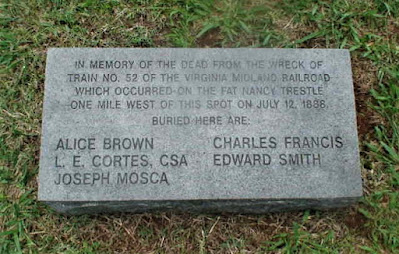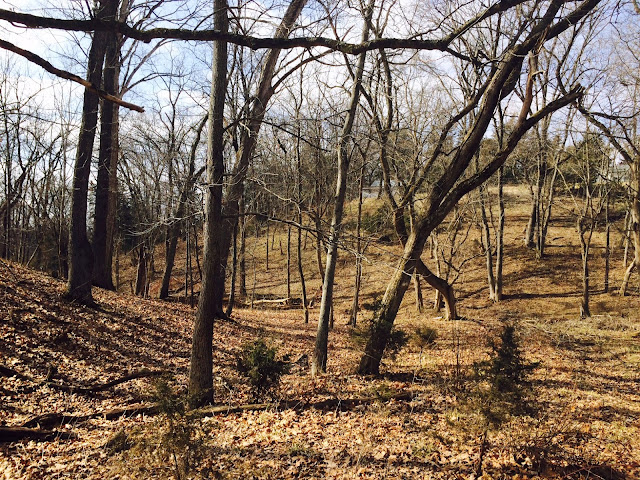 |
| En route to his home in Georgia, James Longstreet was aboard "The Piedmont Airline" when it wrecked at the "Fat Nancy" trestle in Orange County, Va., on July 12, 1888. (Train wreck photo: Images of Orange County | Longstreet photo: William Tipton) |
Sporting astonishingly long, white whiskers, Longstreet was en route to his home in Gainesville, Ga., from the Grand Reunion of Civil War veterans in Gettysburg. The former lieutenant general served as star attraction on that hallowed ground where George Meade out-generaled Lee 25 years earlier. “No man in Gettysburg,” a New York newspaper noted, was “more honored nor more sought than he.”
At roughly 11 p.m., Longstreet boarded the southbound Virginia Midland Railroad’s No. 52 train, “The Piedmont Airline,” in Washington. He traveled with at least two other Confederate veterans — including New Orleans-bound Louis G. Cortes, a “whole-souled, open-hearted, compassionate man” who, as a 19-year-private in the 7th Louisiana, lost his left leg at Gettysburg. Fighting for Brigadier General Harry Hays’ famed “Louisiana Tigers,” Cortez became a prisoner in Pennsylvania and did not get exchanged until early 1864. He also attended the Gettysburg reunion.
The train, scheduled to make stops in Augusta, Georgia; Atlanta and New Orleans, typically carried between 150 and 200 passengers. No. 52 consisted of mail, baggage, smoking and ladies’ cars, three sleepers, the locomotive (Engine 694) and a tender.
 |
| James Longstreet, sporting long, white whiskers, was returning from the Grand Reunion at Gettysburg when the train he was aboard wrecked at the "Fat Nancy" trestle. (William Tipton photo) |
Longstreet sat in a sleeper car as the train snaked its way through countryside ravaged by civil war decades earlier. At roughly 2 a.m., “The Piedmont Airline” arrived with sleeping and groggy passengers in Orange Court House. A short time later, conductor C.P. Taylor eased it out of the station on the Virginia Midland Railroad line. Two miles south of Orange Court House, the train slowed to about 4 m.p.h. as it approached the 44-foot-high, wooden Browning Trestle spanning rain-swollen Two Runs Creek.
Locals called the 470-foot bridge the “Fat Nancy Trestle,” after a plus-sized African American named Emily Jackson, who lived near its western approach. As she stood near the doorway of her house, Jackson would wave her green-checkered, gingham apron at railroad workers, who would toss her apples and oranges from their lunch baskets.
 |
| The train wreck site today. (Special to the blog) |
Then disaster struck.
After the locomotive and tender apparently made it across the bridge, the smoking car in the center of the trestle plunged through wooden beams and into the creek. It dragged the four cars, followed by the tender and locomotive, into the vortex. Two sleepers remained on the track above; the other sleeper, which also fell, rested precariously atop the crumpled wreckage below it.
Frightened passengers, adults and children alike, moaned and cried. Steam hissed from the crippled locomotive. All lights on the train went out after it plunged from the bridge. In the inky blackness, passengers frantically worked to free themselves from the wreckage or to aid the injured.
Thankfully, the wreck didn’t burst into flames or this disaster could have been worse. According to a report, “no pen or tongue” could adequately describe the horror. A survivor from North Carolina said the “cries and groans of the wounded and distressed baffled description.”
Longstreet, a large man, somehow squeezed to safety through a bottom of the sleeper car on the tracks. (Another account said a window.) “He afterwards looked at the hole through which he had emerged,” a newspaper reported, “and wondered how he had ever got through it.” The general, apparently unscathed physically, assisted survivors until daylight and then lay down to rest. Dozens were injured — or worse.
 |
| A historical marker at the site briefly mentions Longstreet. (Special to the blog) |
A month after the death of Cortes — one of scores of Hispanics to serve the Confederacy — the Louisiana Division of the Army of Northern Virginia passed a resolution in the veteran’s honor. “He sleeps … in the sacred soil of Virginia made precious by the best blood of the south,” it read. “Flowers will bloom upon his grave, the birds make melody above him, and at night the stars will watch as sentinels over the sleep of L. G. Cortes.”
Responders found another New Orleans-bound passenger, an “unknown Italian” killed in the accident, with a railroad ticket, a poker chip and three cents. A civil engineer named Cornelius Cox, who had been directing repairs on the trestle, also died in the wreck. A severely injured mail agent died in a Charlottesville hospital five minutes before his wife and brother arrived from Prosper, Virginia. Miraculously, the train’s crew survived.
 |
| Cornelius Cox, a civil engineer who had been directing repairs on the trestle, died in the train accident. He was buried in Congressional Cemetery in Washington (Find A Grave) |
“The [postal] car was broken into kindling wood and I sustained injuries as follows: Left leg broken in three places, right hip badly injured, two ribs broken, both elbows badly injured, paralyzed in stomach and bowels for 10 days and Dr. W.C.N. Randolph said my back from head to hips was bruised so it was as black as a black hat.”
A passenger from Baltimore said it was a miracle how anyone survived the plunge from the trestle. To free the baggage master, who somehow survived under an iron safe and several trunks, rescuers cut away the top of a car.
A couple living nearby in the rural area apparently arrived first to assist the injured. The train’s slightly injured engineer escaped from the wreckage, walked two miles to Orange and telegraphed for help. At about 7 a.m., physicians from nearby Charlottesville arrived on the scene. A local woman did such a fabulous job aiding and comforting the wounded that the railroad company later awarded her $250. The supremely efficient U.S. Post Office Department sent special agents to collect mail that littered the accident scene.
Unsurprisingly, a reporter spotted Emily Jackson, “Fat Nancy,” sitting on a wooden beam near the broken timbers of the trestle watching the rescue.
 |
| After the disaster, the railroad built an embankment with a stone culvert to replace the trestle. (Special to the blog) |
In nearby Charlottesville, anxiety soared.
“As the hours went by the excitement grew very intense,” according to a report, “so much so that when a special train from Orange arrived bearing the wounded the depot and platforms were literally packed, and it was as much as the police could do to keep a passageway clear.”
A reporter quizzed one of the survivors from the sleeper car about the cause of the accident.
“Why, sir,” the man said excitedly, “there were rotten timbers in the trestle and the rotten wood bulged out where the timbers broke. I made careful examination of the structure and am willing to make oath as to its condition.”
 |
| A marker in Graham Cemetery in Orange County, Va., for five of the nine killed in the "Fat Nancy" train wreck. (Find A Grave) |
In newspaper accounts afterward, Longstreet — the most prominent passenger on the train — strangely barely earned a mention. Days later, observers spotted the general in Washington, reportedly seeking a pension for his service in the U.S. Army during the Mexican-American War.
Years after the accident, Longstreet served in another role for the American government: U.S. Commissioner of Railroads under presidents William McKinley and Teddy Roosevelt from 1897-1904.
-- Have something to add (or correct) in this post? Email me here.
- Alexandria (Va.) Gazette, July 18, July 20, 1888
- Baltimore Sun, June 13, 1888
- Charlottesville (Va.) Daily Progress, Oct. 29, 1908
- Greensboro (N.C.) Patriot, July 20, 1888
- St. Louis Globe-Democrat, July 24, 1888
- Shenandoah Herald, Woodstock, Va., July 20, 1888
- The Western Sentinel, Winston-Salem, N.C., July 19, 1888










































